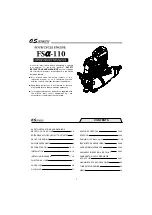
Engine Manual Talon 190 and Lite 125 Ver .99b
4/08/2019
pg. 31
Engine Maintenance
The maintenance of your Paramotor engine should be taken as a proactive step to assure that your
motor works reliably before you take a flight. If you take proper care of your motor and perform the
maintenance as required you can extend the lifespan of the engine for up to 200hrs of flight time. The
last thing you want is for your engine to fail mid-flight leaving you with predicament that could have
been avoided.
When you think about the maintenance of your engine you need to think about how often you fly.
Active pilots can fly up to 100hrs per year or more, and will most likely leave the fuel in their
engine between flights. Leaving the fuel in can actually cause less stress on rubber parts for the
carburetor and fuel lines. Active pilots are more likely to fix or replace items that wear out
sooner like the carburetor gas filter.
Seasonal pilots may only fly 10-20hrs per year and then may not fly for 6 months, and will most
likely remove the fuel from the engine between flights. Seasonal pilots may have to replace
items because they age quickly like the rubber tubes for the gas line. Not using your equipment
can require more maintenance due to how the parts age because oil and fuel have been used in
the engine and this degrades gaskets, diaphragms, fuel lines, filters, etc.
Keep these tips in mind when you think about the maintenance of your Paramotor engine.
Please be aware that the climate you live in can greatly affect the rubber parts on your
Paramotor, direct sunlight and/or high temperatures and/or high humidity are the worst
conditions and degrade these components faster than normal.
Keeping your engine clean will help ensure proper operation, and identify any vacuum leaks
Older versions of the 125 and 190 might have different maintenance timeframes, but the
principal ideas listed below are correct and should be followed. Please check with BlackHawk if
you have an older version.
Maintenance Window for Active Pilots
The maintenance windows for active pilots are broken down by the number of hours the engine has
been flown. Using a tachometer with a time gauge is the best way to determine when the maintenance
on your engine should be done. Also keeping a log of the maintenance you have performed can be a
very helpful tool to make sure you are up to date on the maintenance of your Paramotor engine.
10hr
o
Verify the Cylinder Head Nuts and Propeller Bolts are at the correct torque setting
o
Inspect the Pull Start cord and verify it’s not frayed and pulls freely
o
Verify the Fuel lines are secure and not cracking
o
Verify the electrical wiring and spark plug wires are secure
o
Check the belt tension and make sure it’s not slipping
o
Check the spark plug gap - .025”
















































